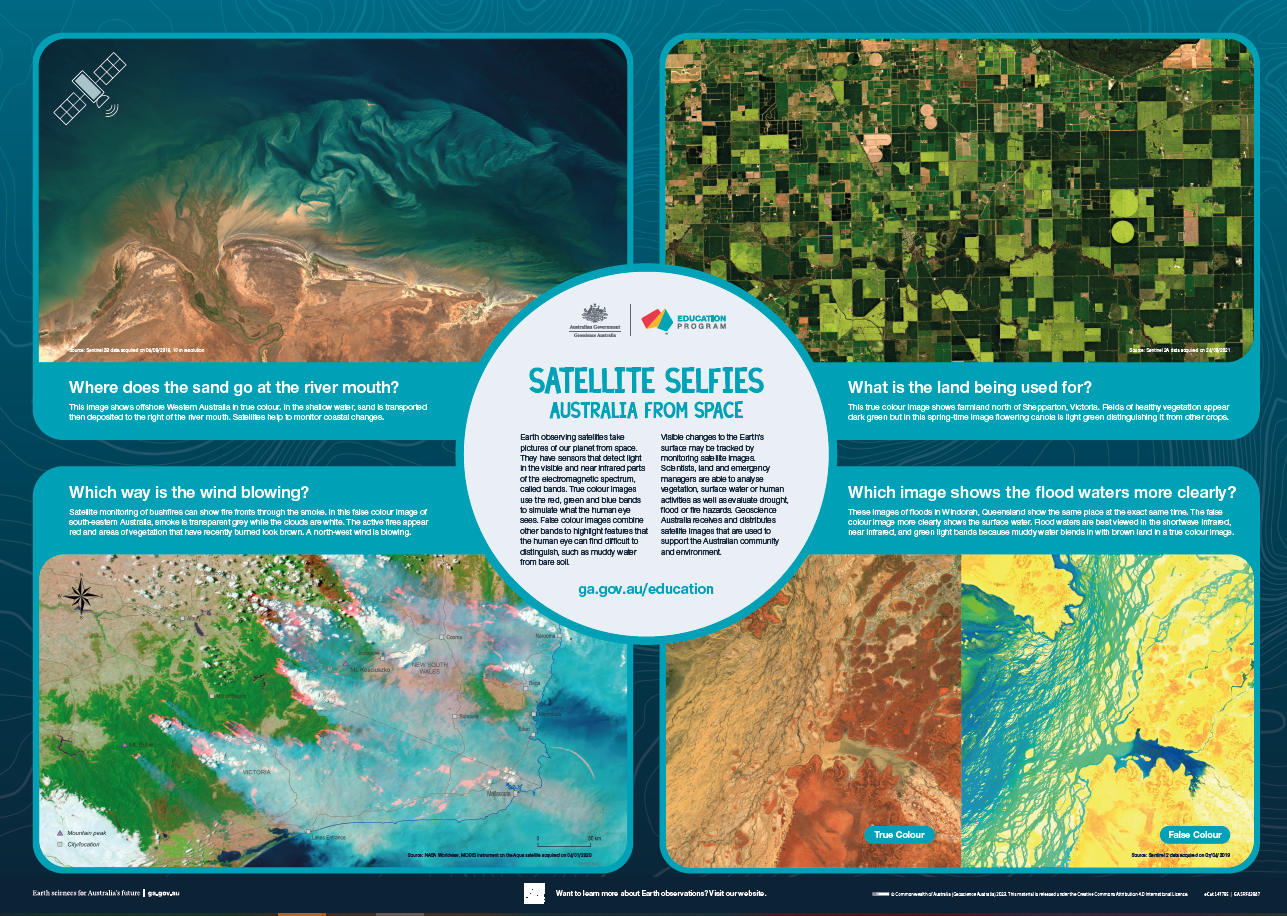Education
Type of resources
Keywords
Publication year
Scale
Topics
-
<div>The A1 poster incorporates 4 images of Australia taken from space by Earth observing satellites. The accompanying text briefly introduces sensors and the bands within the electromagnetic spectrum. The images include examples of both true and false colour and the diverse range of applications of satellite images such as tracking visible changes to the Earth’s surface like crop growth, bushfires, coastal changes and floods. Scientists, land and emergency managers use satellite images to analyse vegetation, surface water or human activities as well as evaluate natural hazards.</div>
-
Australia's Maritime Jurisdiction themed addition to GAV A3 map series commissioned by Communications & Governance Section for educational purposes. Not for sale or general release.
-
Please contact education@ga.gov.au for information regarding the availability of this product.
-
5 educational posters created for the Sapphire Coast Marine Discovery Centre in Eden on Geomorphology, Geology, Land Use and Type, and Seabed Habitats.
-
No abstract available
-
A comprehensive black and white teachers' guide reviews the history and development of the United Nation's Convention on the Law of the Sea and its application to Australian marine jurisdiction. Case studies on the North West Shelf, Antarctica and Orange Roughy are included. 108 page booklet with student activities and suggested answers. Suitable for secondary geography and science students Years 8-12.
-
Weathering, erosion and deposition are all around us. Without these processes we would not have our mountains, river valleys, sandy beaches or even the soil in which we grow our food. This booklet outlines the processes of weathering, erosion and deposition for the information of teachers and students. Inlcudes case studies about the formation of many Australian landforms such as Uluru, the Warrumbungles and the Bungle Bungles. The booklet also includes reproducible student activities that provide students with fun and easy ways to learn about the processes that shape the Earth. - 50 page booklet - 8 student activities - suggested answers A comprehensive resource to introduce your students to the concept of regolith, an important way of looking at, and mapping, the landscape. Suitable for primary Years 5-6 and secondary Years 7-12.
-
Class set comprises 10 copies of the Mt Todd student manual. Each manual contains; - comprehensive teaching notes including map projections, scale, latitude and longitude, direction, geological legends, rock types, rock ages, geological features such as folds, faults, intrusions and dipping rocks, geological cross-sections, the link between geology and topography, economic geology and a glossary. - 11 innovative student activities. Copies of the Mt Todd map, the examination and answers to the student activities are not included in the student manuals as this set is designed to be used in conjunction with the Mt. Todd Map Kit, catalogue item 22055.
-
These videos are recordings of online secondary teacher professional learning sessions, delivered by Geoscience Australia’s Education Team. “Can I Fall Down the Cracks?” Plate Tectonic Misconceptions Part 1 This session focused on common misconceptions that are encountered when teaching plate tectonics. The student misconceptions addressed are: 1. We can’t see the tectonic plates (starting at 5:35) 2. The mantle is made of liquid rock (starting at 11:25) 3. The plates move by convection in the mantle (starting at 17:35) 4. When plates collide one always goes under the other (starting at 22:15) 57 minutes total duration, with Q&A with an expert scientist starting at 34 minutes. “Can I Fall Down the Cracks?” Plate Tectonic Misconceptions Part 2 This session focused on common misconceptions that are encountered when teaching hazards associated with plate tectonics. The student misconceptions addressed are: 1. Earthquakes are measured using the Richter scale (starting at 3:15) 2. The magnitude of an earthquake depends on how far away it is (starting at 7:20) 3. Earthquakes can be predicted (starting at 10:52) This section includes a description of Raspberry Shake equipment: low cost earthquake monitoring for the classroom 4. There are no volcanoes in Australia (starting at 18:25) 5. You can surf a tsunami (starting at 24:17) 51 minutes total duration, with Q&A with an expert scientist starting at 37 minutes.
-
Geoscience Australia acquires satellite imagery from a range of Earth observation satellites. This poster focuses on Australian States and Territories and various satellite applications.

